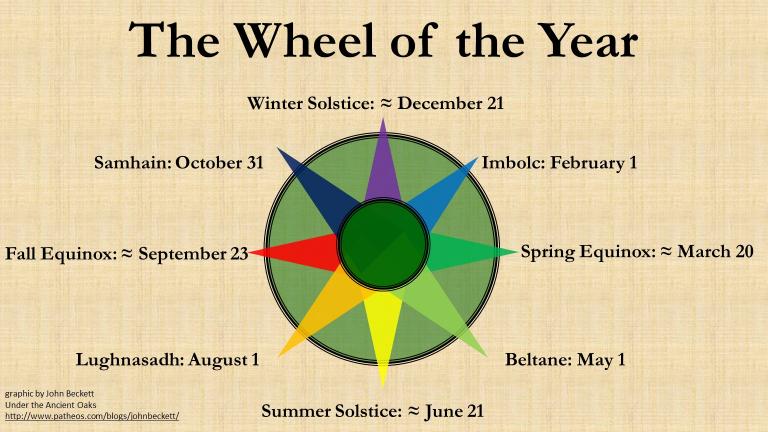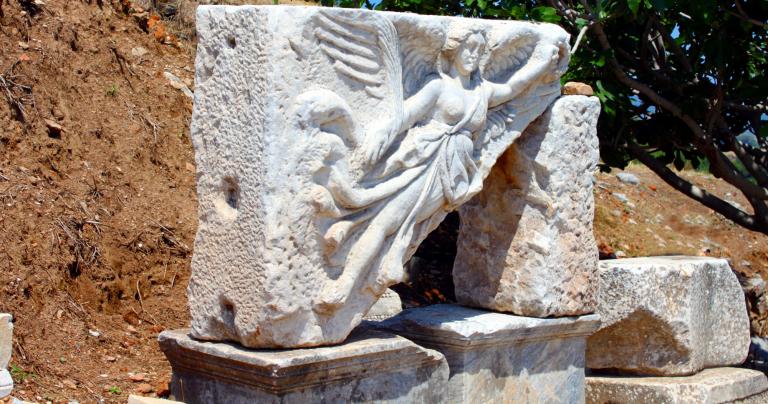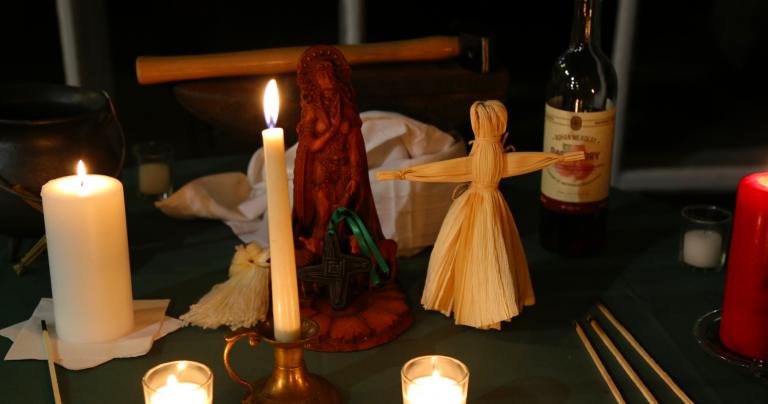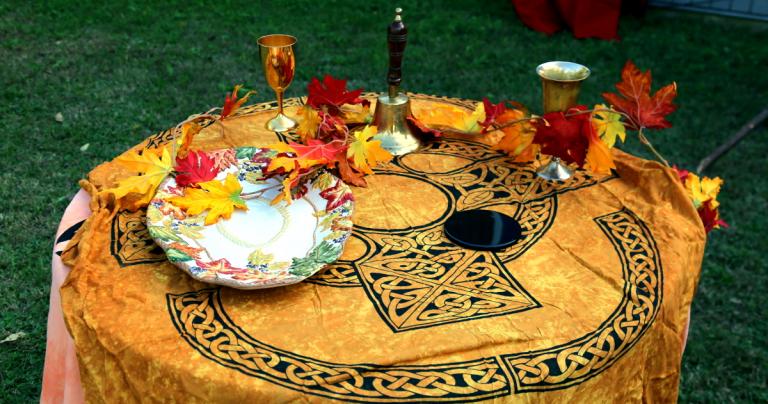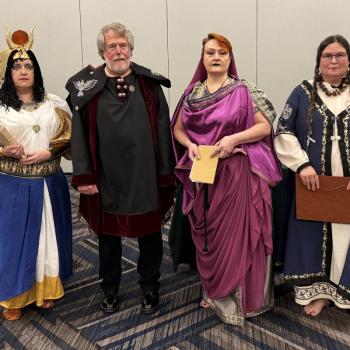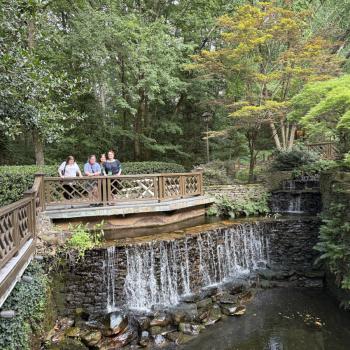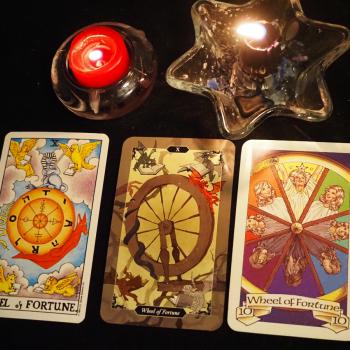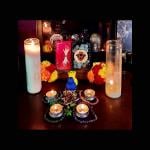I recently had several questions about the Wheel of the Year: the eight major sabbats or high days or holy days of the modern Pagan movement. The Wheel of the Year is one of the first things new Pagans learn, and while it isn’t universal it’s probably more widespread than anything else.
The first questions come from an anonymous reader.
Why is the Wheel of the Year so central to modern Pagan practice?
Modern Paganism has many roots, but among the deepest of those roots is the attempt to rediscover and restore the ancestral religions of Northwestern Europe. We have clear evidence the Celtic cultures celebrated the four fire festivals of Imbolc, Beltane, Lughnasadh, and Samhain. Three of those four align with the Anglo-American observances of Groundhog Day, May Day, and Halloween. And Lughnasadh is the spiritual if not the direct ancestor to the tradition of harvest fairs.
Winter Solstice may be humanity’s oldest holy day, and the Spring Equinox was so important it was New Year’s Day in Britain and America until 1752. The Summer Solstice and Fall Equinox are less important, but they remain on our calendars as the first days of their seasons.
So the first reason the Wheel of the Year is so central to modern Pagan practice is that it’s a mostly-authentic connection to our Pagan ancestors that’s already on our mainstream calendars.
The second reason is that an eightfold calendar gives us a reason to gather and celebrate our Paganism every six or seven weeks. That’s often enough we maintain some continuity, but not so often it becomes routine.
If this is the only thing that Pagans seem to be universally willing to accept as part of their practice, what does that tell us both about the Wheel of the Year as a practice and about Pagan practices in general?
The Wheel of the Year isn’t universal. Some of the ethnic reconstructionists have documented holidays and holy days that don’t line up with the four seasons – they celebrate those instead. The Egyptians had a liturgical calendar that rivals the Catholic church’s calendar of feast days. So did the Greeks and Romans.
The closer you get to the equator, the less obvious the change of seasons becomes, and the less likely a culture will have solar-based holidays. Our most ancient ancestors marked progress through the year by the stars, not by the sun. Some of those observances are encoded in stories that still exist today – this was one of the themes of Gordon White’s 2016 book Star.Ships.
Beyond that, the Wheel of the Year is versatile. It presents a schedule and some basic themes, but no required practices. So you can celebrate Samhain as the end of summer, the final harvest, a remembrance of your ancestors, a contemplation of death, or the feast day of the Morrigan. Or you can skip all that and work magic for hurricane recovery or for favorable election results.
Because the Wheel of the Year can be a blank slate, Pagan traditions that are radically different can keep it but make it their own.
As for how few universals there are in modern Paganism, this points toward the fact that we’re in a speciation phase – we’re developing many different traditions based on the needs and desires of many different people. Over time, I expect that most of those will fade away, and we’ll gather around a handful of paths that show themselves to be especially robust and meaningful.
Longtime friend and UU minister Rev. Eric Posa asks about Paganism in a time of accelerating climate change.
How is celebrating the eight sabbats impacted by seasons growing increasingly out of alignment? What does it mean to acknowledge the turning of the Wheel of the Year, when the Wheel itself is falling out of balance?
Modern Pagans have been talking about this ever since Wicca began to spread beyond England in the 1960s. Why should suburban Pagans in Information Age Los Angeles follow a calendar based on agricultural cycles in Iron Age Britain and Ireland? How much sense does it make to talk about melting snow and cabin fever when your average low in February is 51°F (10°C)?
A few people have tried to move sabbat dates based on the local climate. In 2014 I wrote about how I could refocus the sabbats here in North Texas to match our climate. I don’t know of any that have been widely adopted, other than Southern Hemisphere Pagans flipping the Wheel to align with their seasons. They’re getting ready to celebrate Beltane now. I might argue that they should have acknowledged the reversed seasons but kept the fire festivals as is. But this works for them, so that practice appears to be settled.
For all that the primary focus of my religion is the worship of the many Gods, I remain a Nature-centered Pagan. Following the annual progression of the sun and the monthly progression of the moon is part of my regular spiritual practice. Observing the changing seasons is part of being connected to the land where I live, where ever that happens to be. Imbolc is for Brighid, but it’s also the Promise of Spring. Samhain is for the ancestors and the Otherworld, but it’s also about Summer’s End (which in Texas is cause for major celebration).
My expectation is that we’ll keep the Wheel of the Year as is. The solstices and equinoxes aren’t changing, and the fire festivals have strong historical ties to calendar dates. But how we celebrate will almost certainly change.
Another anonymous reader asks what the Wheel of the Year might look like in 200 years.
Paganism is already a collection of many religions, not just one. What the Wheel of the Year will look like in the future depends on whether these many religions will ultimately be universal or local.
Our ancient ancestors understood that different people worshipped different Gods in different ways, and they interacted with different lands in different ways. Christianity and later Islam claimed to be a universal religion for everyone everywhere. Imperialism tried to impose cultural norms from cool, damp Britain on places like Egypt and Australia. Pirates of the Caribbean is fiction, but Elizabeth Swann is far from the only person to pass out from overdressing in the tropics.
Our individual Pagan religions will have their own liturgical calendars, but the Wheel of the Year will remain a Pagan near-universal. We will continue to explore the Otherworld at Samhain, anticipate the return of the light at Yule, and celebrate our sensuality and sexuality at Beltane – hopefully with a stronger message of consent than we’ve done in the recent past.
But the other spokes on the Wheel are likely to change, some locally and others universally. And if climate change is anywhere near as bad as the projections say it will be, I imagine one of those spokes will become a Day of Mourning, or perhaps the Pagan equivalent of the Jewish Yom Kippur – a Day of Atonement.
The Wheel of the Year is central to modern Pagan practice because it’s an authentic and accessible connection to both our ancestors and to Nature. It gives us a framework for celebration and worship, but it does not insist we celebrate or worship in any particular way.
Over time, different Pagan traditions will find different ways to mark each spoke on the Wheel. Some will become widespread, some will remain local, and some will fade away. Our changing climate will demand other changes, lest we become proper English ladies and gentlemen giving ourselves heat stroke from wearing London fashion in Jamaica.
But the Wheel of the Year will endure, because it works.


